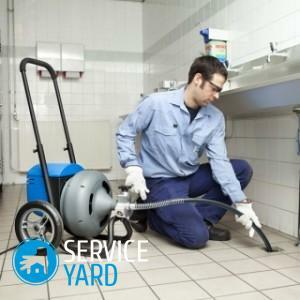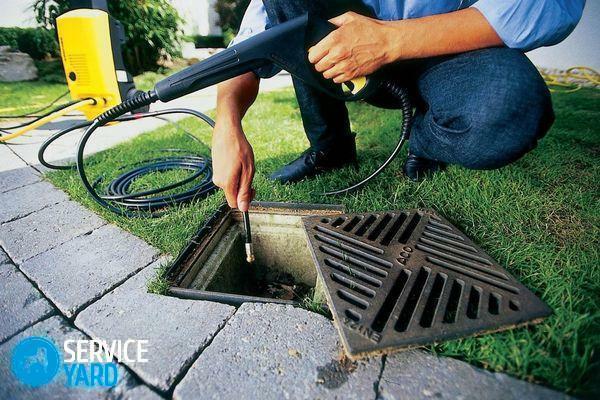
- Cleaning methods
- How do I clean the roof system?
- Cleaning of the open system
- Cleaning of the closed system
- Prevention of obstructions
- Professional cleaning methods
Storm sewage( or rainfall) is one of the most important elements of the improvement of the house area. The purpose of the storm catcher is to collect rainwater or melt water and bring it out of the territory. Over time, trays and pipes of storm sewage are filled with debris - branches, pebbles, leaves. As a result, we get clogging, which reduces the efficiency of the system to almost zero. If such a situation arises, it is necessary to clean the storm sewer. You can do this work yourself, but you can contact a specialized organization.
to the contents ↑Cleaning methods
Like all communications, storm water drain requires periodic maintenance. If there is a blockage in the sewage canal, it is necessary to remove debris, flushing channels and pipes. As a rule, cleaning is carried out 1-2 times a year:
- In spring it is necessary to inspect the sewage system carefully when the bulk of the snow melts.
- It is advisable to audit the system in the autumn period.
Important! It is necessary to audit storm sewage, if you performed roof repairs. The reason is that construction debris and bits of bitumen fall into the sewage system, which causes clogging.
to the contents ↑How to clean the roof system?
When stagnant rainwater on the roof should begin inspection of stormwater from downpipes, funnels and drainage chutes. Make sure that these structures are not littered. If clogs are present, they must be removed. To do this, it is enough to mechanically collect branches, leaves and other debris.
Water intake funnels, protected by caps and grids, are clogged less often.
Important! Eliminate the obstructions in the funnels best of all with water, which is fed from the hose under pressure.
to the contents ↑Cleaning of the open system
When used in the site of a storm shower of an open type, cleaning of its special complexity does not represent. Clean the storm sewer in the following order:
- Remove the grilles that cover the trays.
- Remove the debris accumulated in the channel.
- Rinse the channels by directing water under pressure in them.
- Place the grilles in their original position.
Cleaning of the closed system
Clearing the closed-type closed-type storm is more difficult. Clean the buried pipes underground by a hydrodynamic method - water that is supplied under pressure. A strong stream of water destroys plugs of sand, dirt and debris, and the sewage system becomes functional again.
The effectiveness of the method depends on the power of the water head and the diameter of the pipes used. For example:
- If pipes with a diameter of 200 mm were used on the site( most often, this is the case), then a regular car wash that supplies water under pressure up to 350 bar is enough to eliminate blockages.
- If you use pipes of a larger cross section, you can not do without the help of a specialized company.
Important! To better clean the sewer better, water is fed in two directions. First - from the intake device to the collector( in the direction of the natural water current), then - in the opposite direction.
to the contents ↑Prevention of obstructions
To reduce the need to wash storm sewage more rarely, special treatment facilities should be used. For example, rainwater receivers are equipped with special filters that delay debris and prevent the formation of blockages.
Types of filters
Here is a list of cleaning devices that prevent fast clogging of stormwater.
- Sorption block.
- Sand trap.
- Filter, which cleans water from oil products.
- Separator, sump.
- Station of UV-disinfection of water.
Important! When purchasing this or that cleaning device, it is necessary to take into account the operating conditions of the storm shower. For example, for a country or a private house it is enough to buy a sand catcher. Other elements are used for the installation of industrial sewers.
Design rules
To resort to large-scale clean-up operations as little as possible, or even better, to avoid them, it is necessary to adhere to the following rules when arranging storm showers:
- Design of storm sewerage in accordance with the requirements of SNiP.
- Sanitary installation without too long or curved sections.
- In places where there are turns, tie-ins, forks, it is necessary to equip manholes.
- Pipes are preferably used with a smooth inner surface.
- If the sewerage cleaning should be done 1-2 times a year, regular inspection and cleaning of the treatment facilities should be regular, in particular, after heavy showers and leaf fall.
Important! In no event should it be possible to store loose building materials near a storm sewage system or to equip a temporary landfill. Timely cleaning of the territory of garbage is one of the most important factors of not clogged storm sewers. If you neglect this rule, after the first rain, you may need to clean the storm sewer.

Sand catchers:
design features Install a sand catcher at the entrance to the pipe. The device is extremely simple: water enters the device through the upper part, and pours out through the lateral holes located above the bottom. Due to the level difference, a settler is formed. Sand and heavy debris settle to the bottom.
Important! Manufacture of sand trap from polymer concrete or plastic. The most common option is a removable PVC basket. It has a small mass, and it is easy to clean from accumulated debris.
to the contents ↑Professional cleaning methods
Professional companies that provide similar services use the following methods:
- Mechanical - punching plugs and removing dirt mechanically.
- Hydrodynamic - washing storm sewage with a water jet, which is supplied under pressure.
- Thermal - elimination of contamination by steam and hot water.
- Chemical - the use of chemical reagents that destroy clogs, but are safe for pipes.
Important! The most common method of cleaning rainwater is mechanical.
Flushing of storm water sewage using special equipment
Preventive or emergency works on large sewerage systems require the services of professional specialists and specialized equipment. The amount of sandy-silt deposits in wells and pipes can be measured in tens of cubic meters, and removing them by hand is simply unrealistic.
For the professional cleaning of rainstorms, channel washers and vacuum systems are used. The equipment is installed on the wheelbase of heavy-duty trucks.
Important! Some models of modern equipment perform both functions: pumping silt and washing operations with the help of powerful hydrants.
Description of flushing technology:
- A brigade with a prefilled flushing machine arrives at the facility.
- A high-pressure hose( to a depth of 1-2 m) is inserted into the well.
- The washing process is performed when the water head is supplied with 180-200 bar.
- Water washes off the sludge deposits and they drain to the well. .
- After washing the entire area, the hose is folded while continuing to feed water. The quality of the pipe washing will be better.
- Wipes are cleaned from the well manually. With a large amount of sediment, the silt is removed with a silos plant. In the silos bunker, the mud is separated from the water, and it can be reused.
Important! Emptying of silos is carried out on a specially prepared site or on a landfill.
Cleaning the storm sewer by pneumatic method
This method is used when the layers are petrified and do not lend themselves to hydraulic cleaning. The essence of the method is as follows:
- Special pneumatic cartridges are introduced into the cleaning area, with the help of which local water hammers are created.
- This results in a short-term change in the geometry of the sewer pipe.
Important! On the integrity of the rainfall it does not affect, but the cleaning turns out to be quite effective. The method is quite expensive, but in some cases the only possible.
Proper planning and arrangement of the storm shower, its timely inspection and cleaning, compliance with operating rules and simple preventive measures avoid the use of expensive cleaning services.



